In 2021, several hundred more scientific papers were published that cast doubt on the position that anthropogenic CO2 emissions function as the climate’s fundamental control knob…or that otherwise serve to question the efficacy of climate models or the related “consensus” positions commonly endorsed by policymakers and mainstream media sources.
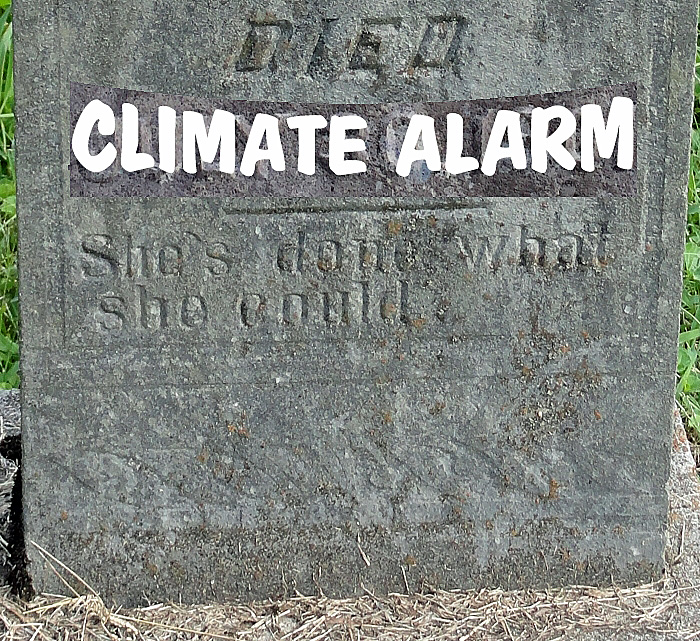
These scientific papers affirm the position that there are significant limitations and uncertainties inherent in our understanding of climate and climate changes…emphasizing that climate science is not settled.
More specifically, the papers in this compilation support these four main skeptical positions — categorized here as N(1) – N(4) — which question the climate alarm popularized in today’s headlines.
N(1) Natural mechanisms play well more than a negligible role (as claimed by the IPCC) in the net changes in the climate system, which includes temperature variations, precipitation patterns, weather events, etc., and the influence of increased CO2 concentrations on climatic changes are less pronounced than currently imagined.
N(2) The warming/sea levels/glacier and sea ice retreat/precipitation extremes…experienced during the modern era are neither unprecedented or remarkable, nor do they fall outside the range of natural variability.
N(3) The computer climate models are neither reliable or consistently accurate; the uncertainty and error ranges are irreducible; and projections of future climate states (i.e., an intensification of the hydrological cycle) are not supported by observations and/or are little more than speculation.
N(4) Current emissions-mitigation policies, especially related to the advocacy for renewables, are often ineffective and even harmful to the environment, whereas elevated CO2 and a warmer climate provide unheralded benefits to the biosphere (i.e., a greener planet and enhanced crop yields, lower mortality with warming).
In sharp contrast to the above, the corresponding “consensus” positions that these papers do not support are:
A(1) Close to or over 100% (110%) of the warming since 1950 has been caused by increases in anthropogenic CO2 emissions, leaving natural attribution at something close to 0%.
RealClimate.org: “The best estimate of the warming due to anthropogenic forcings (ANT) is the orange bar (noting the 1𝛔 uncertainties). Reading off the graph, it is 0.7±0.2ºC (5-95%) with the observed warming 0.65±0.06 (5-95%). The attribution then follows as having a mean of ~110%, with a 5-95% range of 80–130%. This easily justifies the IPCC claims of having a mean near 100%, and a very low likelihood of the attribution being less than 50% (p < 0.0001!).”
A(2) Modern warming, glacier and sea ice recession, sea level rise, drought and hurricane intensities…are all occurring at unprecedentedly high and rapid rates, and the effects are globally synchronous (not just regional)…and thus dangerous consequences to the global biosphere and human civilizations loom in the near future as a consequence of anthropogenic influences.
A(3) The climate models are reliable and accurate, and the scientific understanding of the effects of both natural forcing factors (solar activity, clouds, water vapor, etc.) and CO2 concentration changes on climate is “settled enough”, which means that “the time for debate has ended”.
A(4) The proposed solutions to mitigate the dangerous consequences described in N(4) – namely, wind and solar expansion – are safe, effective, and environmentally-friendly.
To reiterate, these scientific papers compiled in 2021 support the N(1)-N(4) positions, and they undermine or at least do not support the “consensus” A(1)-A(4) positions. These papers do not do more than that. In other words, it is too ambitious to claim these papers prove that anthropogenic global warming (AGW) positions are invalid, or that AGW claims have now been “debunked”.
Below are the two links to the list of scientific papers for 2021 as well as an outline to their categorization.
Skeptic Papers 2021 (1)
Skeptic Papers 2021 (2)
1. Climate Change Observation, Reconstruction
A Warmer Past: Non-Hockey Stick Reconstructions
No Net Warming Since Mid/Late 20th Century
Lack Of Anthropogenic/CO2 Signal In Sea Level Rise
Sea Levels Multiple Meters Higher When CO2 <280 ppm
Glaciers, Ice Sheets, Sea Ice
Abrupt, Degrees-Per-Decade Natural Global Warming
2. Natural Mechanisms Of Weather, Climate Change
Solar Influence On Climate
ENSO, NAO, AMO, PDO Climate Influence
Climate/Precipitation Natural Variability
Cloud Climate Influence
The CO2 Greenhouse Effect – Climate Driver?
Unsettled Science, Failed Climate Modeling
Failing Renewable Energy, Climate Policies
Corals Thrive In Warm, High CO2 Environments
Elevated CO2, Warmth, Does Not Harm The Biosphere
Elevated CO2: Greens Planet, Higher Crop Yields
Global Warming Reduces Mortality. Cold Kills.
Urbanization Artificially Adds To Warming Trend
Fires
No Increasing Trends In Intense Hurricanes
No Increasing Trend In Drought Frequency, Severity
Natural CO2 Emissions A Net Source, Not A Net Sink
Elevated CO2 Does Not Harm Human Cognition
Miscellaneous
Below are a few samples of the papers contained in the database.
[T]he modern definitions of climate are seriously affected by the wrong perception of the previous two centuries that climate should regularly be constant, unless an external agent acts upon it. … [H]eat exchange by evaporation (and hence the latent heat transfer from the Earth’s surface to the atmosphere) is the Earth’s natural locomotive, with the total energy involved in the hydrological cycle being 1290 ZJ/year, corresponding to an energy flux density of 80 W/m2. Compared to human energy production (0.612 ZJ/year for 2014), the total energy of the natural locomotive is 2100 times higher than that of the human locomotive … Even though in the common perception it is carbon dioxide (CO2) that determines the greenhouse effect of the Earth, recent studies (Schmidt et al. [69]) attribute only 19% of the longwave radiation absorption to CO2 against 75% of water vapour and clouds, or a ratio of 1:4. … Another misconception, common in nonexperts, is that atmospheric CO2; is the product of human emissions, while in fact the latter contribute only 3.8% to the global carbon cycle. … [U]sing reliable instrumental measurements of global T and CO2 concentration covering the time interval 1980–2019, a recent study found that in the relationship of CO2 and temperature, the dominant causality direction is T → CO2, rather than the other way round, despite the latter being the common perception.
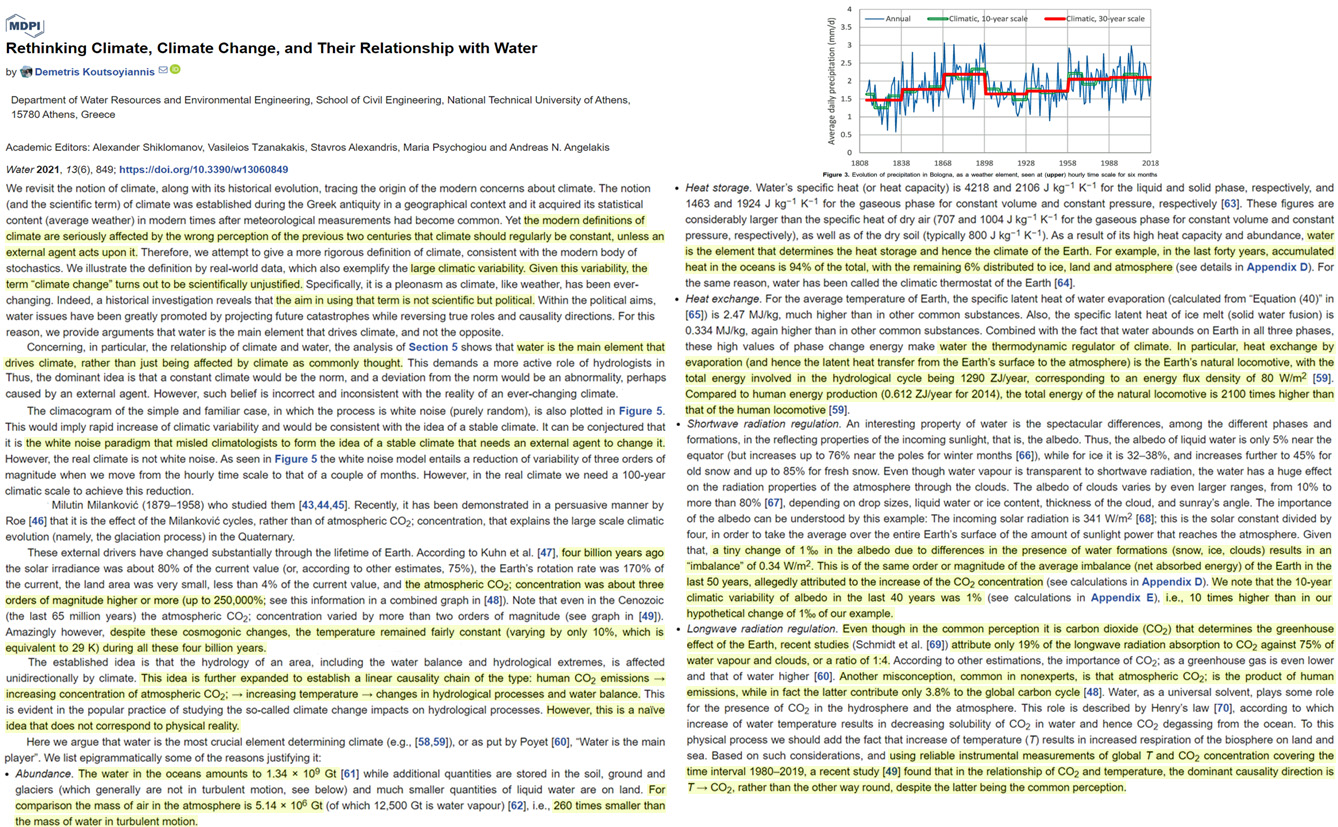
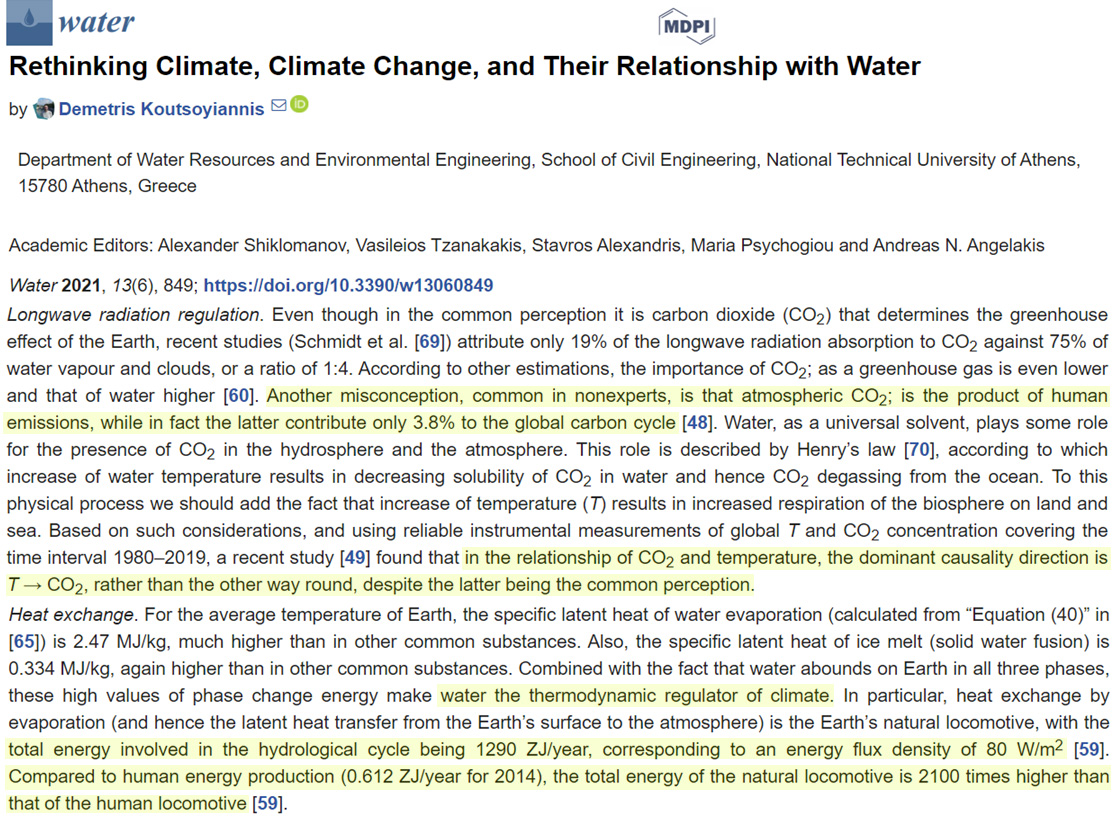
Because carbon dioxide molecules do not absorb in the additional spectrum range between 1200 cm−1 and 2600 cm−1, the radiative parameters due to CO2 molecules are close in these evaluations and in the previous one. In particular, the variation in radiative fluxes as a result of the change in the carbon dioxide amount in the atmosphere for these calculations are close. In this evaluation as well as previous evaluations, we have a contradiction with the results of climatological models in the analysis of the Earth’s greenhouse effect, according to which the increase in the global temperature differs by five times. [T]he large difference results from ignoring, in climatological models, the Kirchhoff law [50], according to which radiators are simultaneously the absorbers. In this case, we take the change in the radiative flux created by CO2 molecules as the change of the total radiative flux.
Note the restrictions by the frequency range up to 1200 cm−1 in the previous calculations [1]; we thus assume that the atmosphere is transparent for larger frequencies, and the emission at larger frequencies is determined by clouds. However, according to the HITRAN data bank, water molecules absorb effectively in the enlarged frequency range. [A]tmospheric CO2 molecules are not the main radiator of the atmosphere. From these evaluations, it follows that water molecules in the atmosphere may be responsible for the observed heating of the Earth.
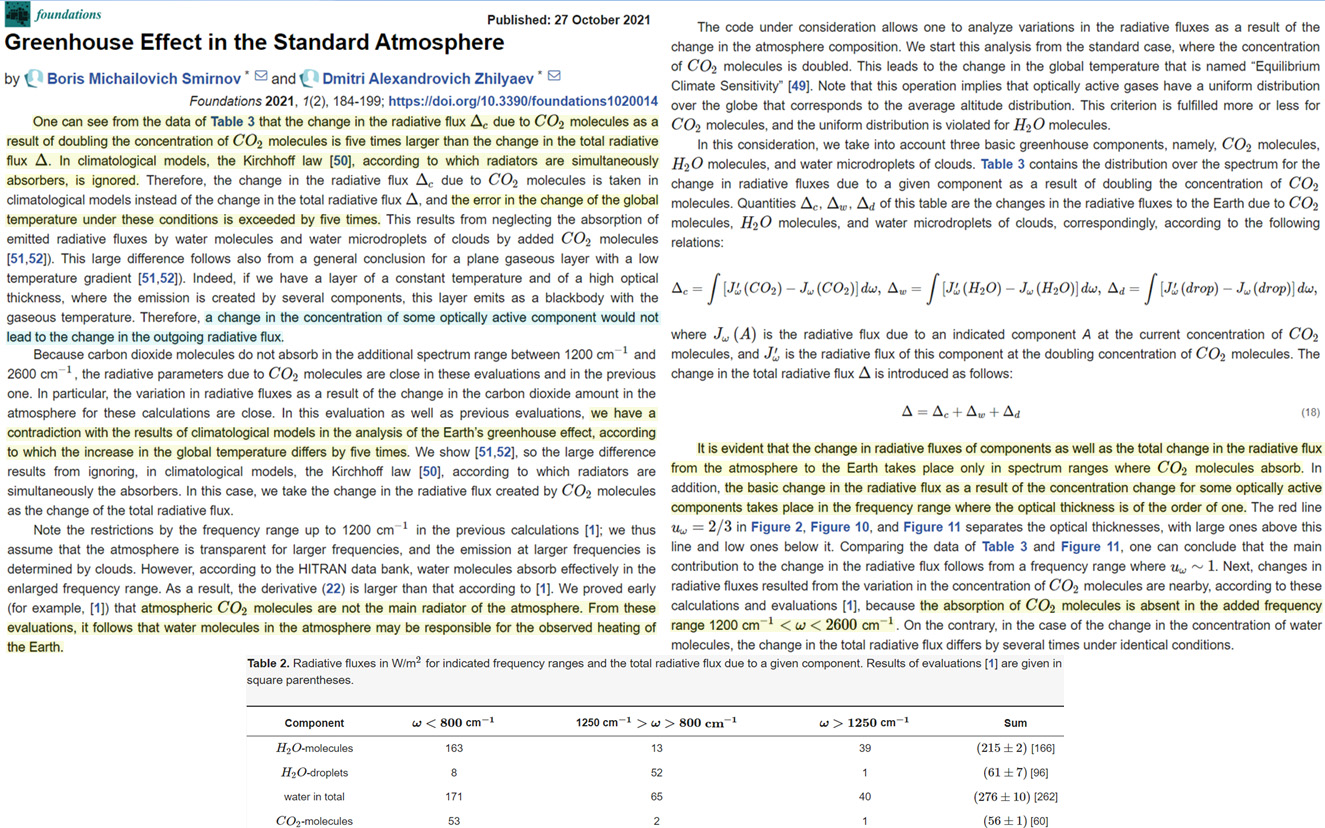
The HITRAN database of gaseous absorption spectra enables the absorption of earth radiation at its current temperature of 288K to be accurately determined for each individual atmospheric constituent and also for the combined absorption of the atmosphere as a whole. From this data it is concluded that H2O is responsible for 29.4K of the 33K warming, with CO2 contributing 3.3K and CH4 and N2O combined just 0.3K. Climate sensitivity to future increases in CO2 concentration is calculated to be 0.50K, including the positive feedback effects of H2O, while climate sensitivities to CH4 and N2O are almost undetectable at 0.06K and 0.08K respectively. This result strongly suggests that increasing levels of CO2 will not lead to significant changes in earth temperature and that increases in CH4 and N2O will have very little discernable impact.
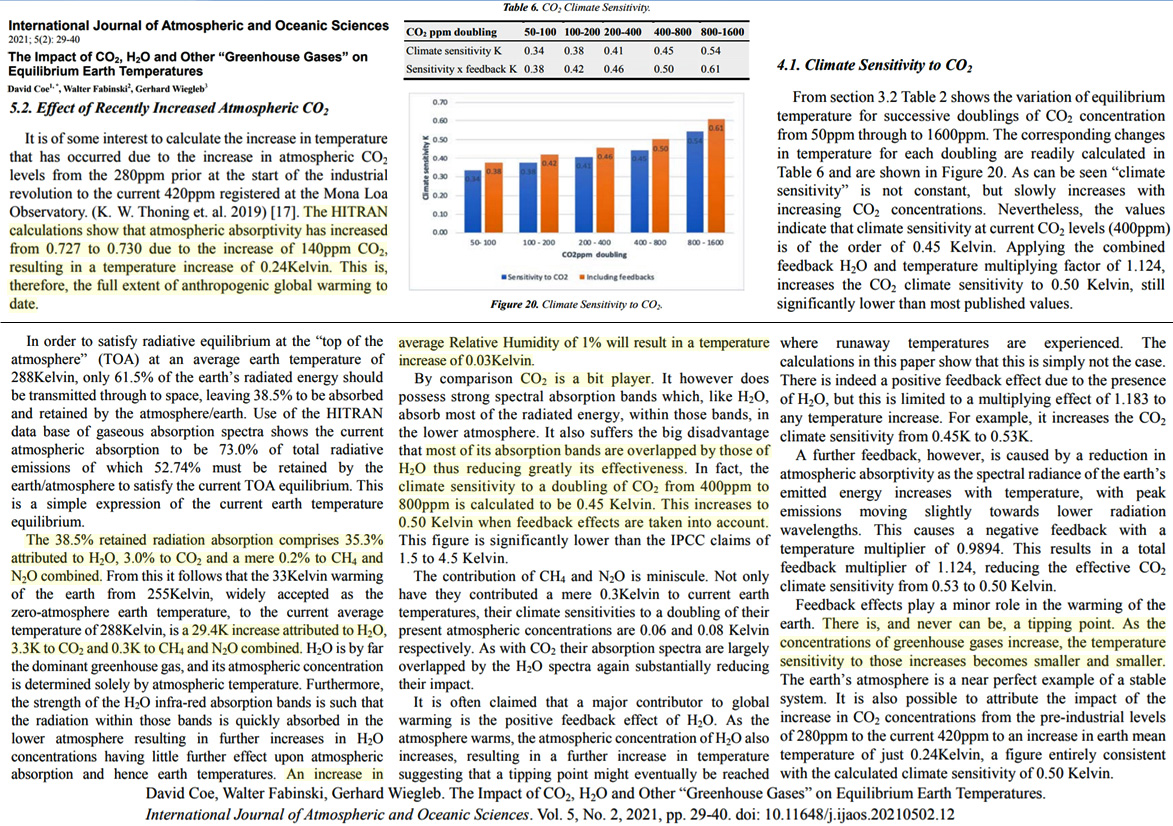
The paper aims to quantify solar and anthropogenic influences on climate change, and to make some tentative predictions for the next hundred years. By means of double regression, we evaluate linear combinations of the logarithm of the carbon dioxide concentration and the geomagnetic aa index as a proxy for solar activity. Thereby, we reproduce the sea surface temperature (HadSST) since the middle of the 19th century with an adjusted R2 value of around 87 percent for a climate sensitivity (of TCR type) in the range of 0.6 K until 1.6 K per doubling of CO2. The solution of the double regression is quite sensitive: when including data from the last decade, the simultaneous occurrence of a strong El Niño and of low aa values leads to a preponderance of solutions with relatively high climate sensitivities around 1.6 K. If these later data are excluded, the regression delivers a significantly higher weight of the aa index and, correspondingly, a lower climate sensitivity going down to 0.6 K. The plausibility of such low values is discussed in view of recent experimental and satellite-borne measurements. We argue that a further decade of data collection will be needed to allow for a reliable distinction between low and high sensitivity values. In the second part, which builds on recent ideas about a quasi-deterministic planetary synchronization of the solar dynamo, we make a first attempt to predict the aa index and the resulting temperature anomaly for various typical CO2 scenarios. Even for the highest climate sensitivities, and an unabated linear CO2 increase, we predict only a mild additional temperature rise of around 1 K until the end of the century, while for the lower values an imminent temperature drop in the near future, followed by a rather flat temperature curve, is prognosticated.
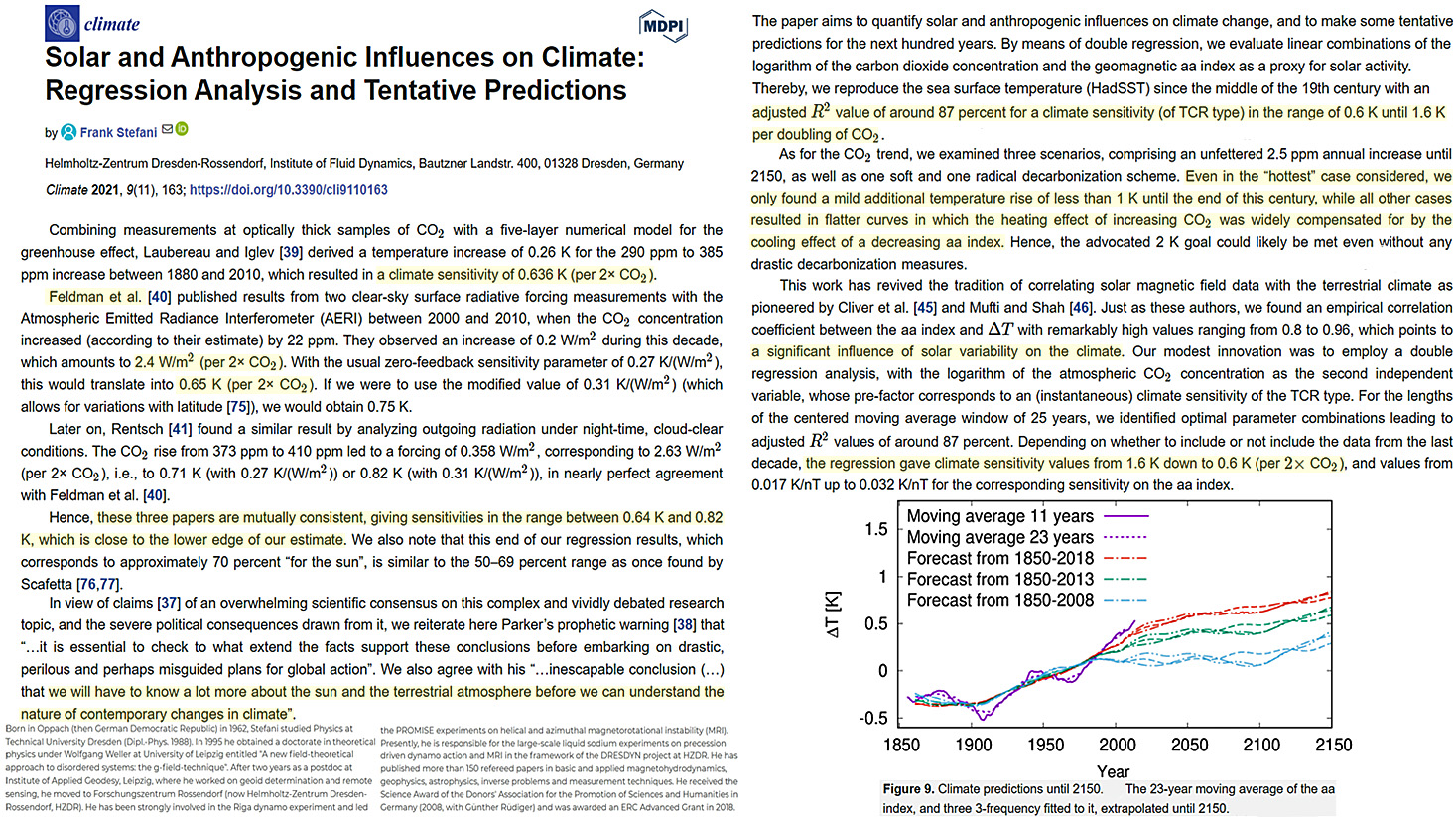





Of course these papers collectively debunk the AGW scare.
And of course we the people have been conned. A backlash is to be expected.
Is it time for a thorough investigation of this situation, using the model of the investigation conducted by Reiner Fuellmich and Viviane Fischer, whose Grand Jury is now being held for all of the world to see?
[…] Hundreds More Papers Published In 2021 Support A Skeptical Position On Climate Alarm […]
[…] Fonte: No Tricks Zone […]